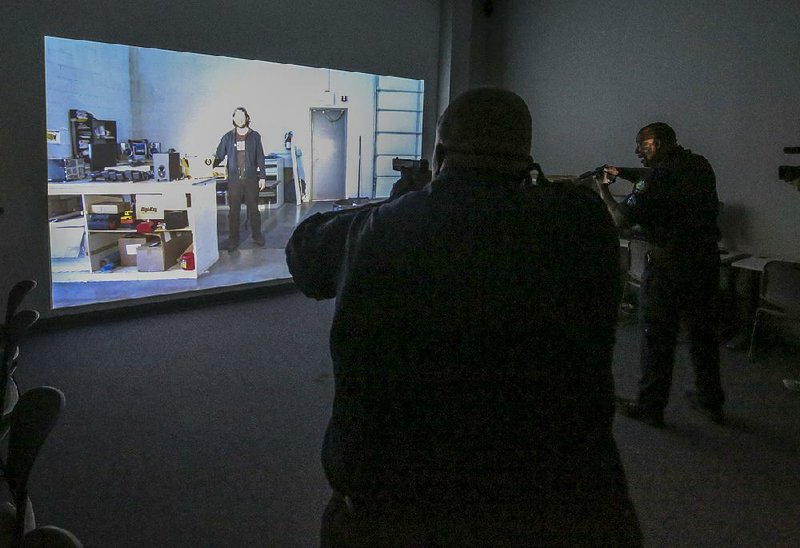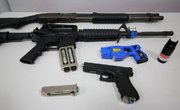Little Rock police officers Herb Kimbrough and Ira Whitfield walked into an office supply store, pistols drawn, after an alarm at the business went off about midnight.
The alarm had gone off several times that week after-hours. This time, as the two walked inside the dimly-lit building and announced themselves as police officers, a man stood up from a behind a desk.
Kimbrough and Whitfield asked the man to show his hands, but the man didn't listen. He kept his right hand hidden behind a box, cursed at the officers and told them he worked there.
"You want to see my ID? I got it right here," the man said, motioning to his hidden hand.
The man quickly moved the hand toward officers. He was holding a metallic object.
It was a staple gun.
Kimbrough and Whitfield exhaled.
"Put the staple gun down, man," Whitfield said.
That encounter didn't occur on the streets of Little Rock. It happened Thursday afternoon in a white room at the Police Department's training division.
Kimbrough and Whitfield were demonstrating the department's use-of-force training simulator, a $110,000 system purchased in 2010 that's used to instruct officers on deadly force and de-escalation tactics.
Little Rock police recently spent about $12,000 to upgrade the system, adding new scenarios and improving the speed and accuracy with which it documents an officer's response, according to training division instructor officer John Gilchrist.
The simulator, manufactured by Ti Training Corp., projects high-definition video of real-life actors and environments onto a wall or other flat surface. Officers are equipped with replica weapons -- handguns, Tasers, long rifles, pepper spray -- that fire invisible lasers, similar to a video game.
Little Rock police use the simulator to train for more than 100 scenarios, each of which can be altered to require officers to use force or not. Scenarios include traffic stops, reports of a suspicious person and active shooters.
"We're trying to really get officers to think through everything they encounter," department spokesman Lt. Steve McClanahan said. "Not everybody out there is going to pull a weapon or have a knife. Just because they're not complying with commands, that doesn't mean that deadly force is justified."
Gilchrist, who has spent the past four of his 29 years with Little Rock police in the training division, said officers train using the simulator for about 30 minutes per year. It's part of the department's 40 hours of required annual training. Recruits typically train for several hours in the simulator.
Gilchrist said the simulator is used to evaluate more than firearm skills. The training division uses it to critique an officer's communication and judgment in a given scenario. Some scenarios call for patience and restraint. Others test how quickly an officer can defend himself.
In each case, Gilchrist said, an officer has to justify his choices.
"There's consequences to every action," he said. "We're hopeful that this kind of training expands on the real-life experiences that people have not yet had."
Little Rock police and hundreds of other law enforcement agencies have used training simulators for decades. Older versions of the Little Rock police simulator were less realistic, according to McClanahan. He said the guns weren't as lifelike, the number of scenarios was limited and the videos were projected onto smaller surfaces.
Use of the simulators has reportedly expanded over the years as technology has improved and the cost has become less prohibitive. Demand has also risen as research has proven the technology's effectiveness.
A Carleton University of Canada study in 2005 found that simulator training improved motor skills and critical decision-making.
"Objectively, simulation training has been demonstrated to increase the number of preventative actions taken by police officers, enhance shooting accuracy, reduce the number of shots fired to achieve an objective, increase the degree to which officers use cover, and decrease the number of unjustified shootings," the study states.
But not everything can be simulated.
As officers Kimbrough and Whitfield handled the simulated alarm call Thursday, they could not re-position themselves for a better view or spread out to gain a tactical advantage on the agitated man they'd encountered. They were confined to four walls, forced to approach the situation head-on instead of seeking cover or concealment, as they're trained.
Gilchrist said instructors sometimes reinforce the importance of cover by placing a mailbox or car door in the simulation room.
"Yes, we're limited as to what our police officers can do in here," he said. "But we have the best tools available in order to get them to start thinking outside the box."
Kimbrough and Whitfield shot the man after he pointed a gun at them in one of the simulations. Speakers filled the room with the sound of gunfire, and cross-hairs showing the location of the shots appeared on screen.
Neither officer has fired a gun on duty in their combined 34 years in law enforcement. But they said their hearts were beating as though they had after the simulation Thursday.
Four Little Rock police officers have been involved in real shootings this year.
Last month, officer Jonathan Gonzalez fatally shot Austin Dakota Snyder, 22, as Snyder tried to flee police in a hotel parking lot, the department reported. Snyder reportedly rammed a vehicle and ignored commands to show his hands before Gonzalez opened fire.
In March, officers Brian Osmundson and Samuel Hill fatally shot Michael Hornibrook, 54, in the city's River Market District downtown, according to reports. Police said the officers shot Hornibrook when he raised a gun toward them.
In February, officer Angela Everett shot and killed Gregory Childress, 44, when Childress tried to rob her at gunpoint, according to police. Everett had been working off-duty as a security guard and was wearing her police uniform.
Investigations of the shootings are ongoing.
Metro on 05/05/2017


